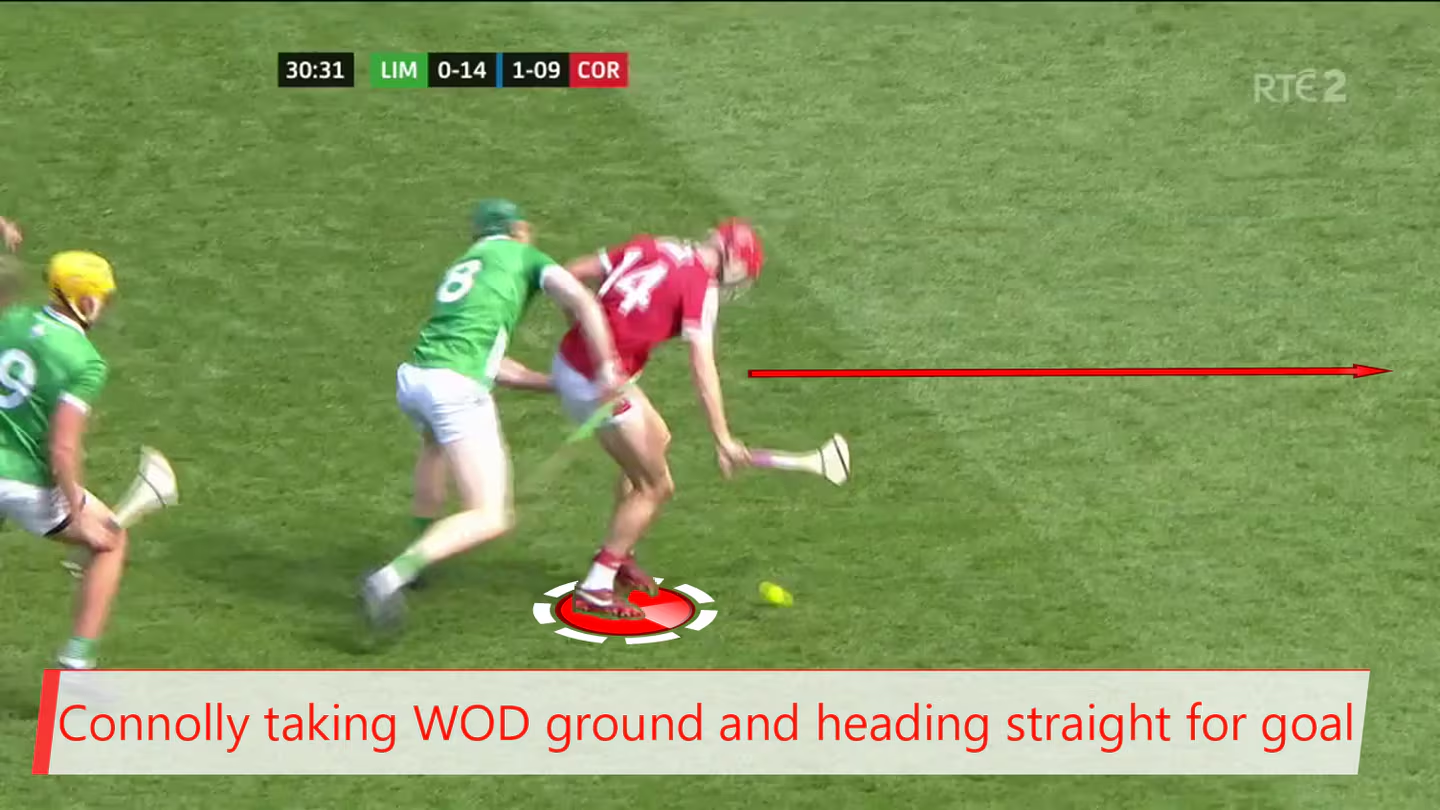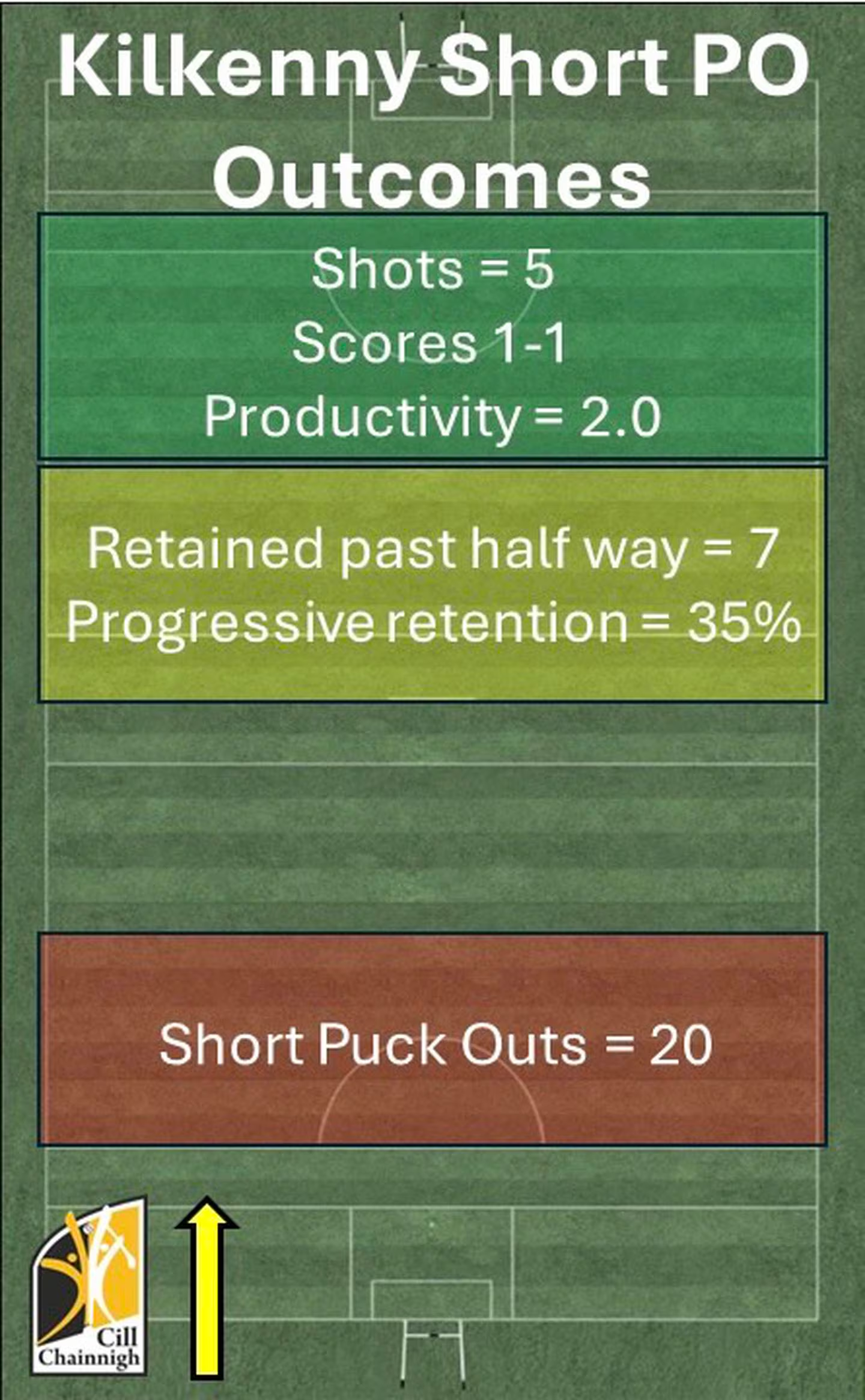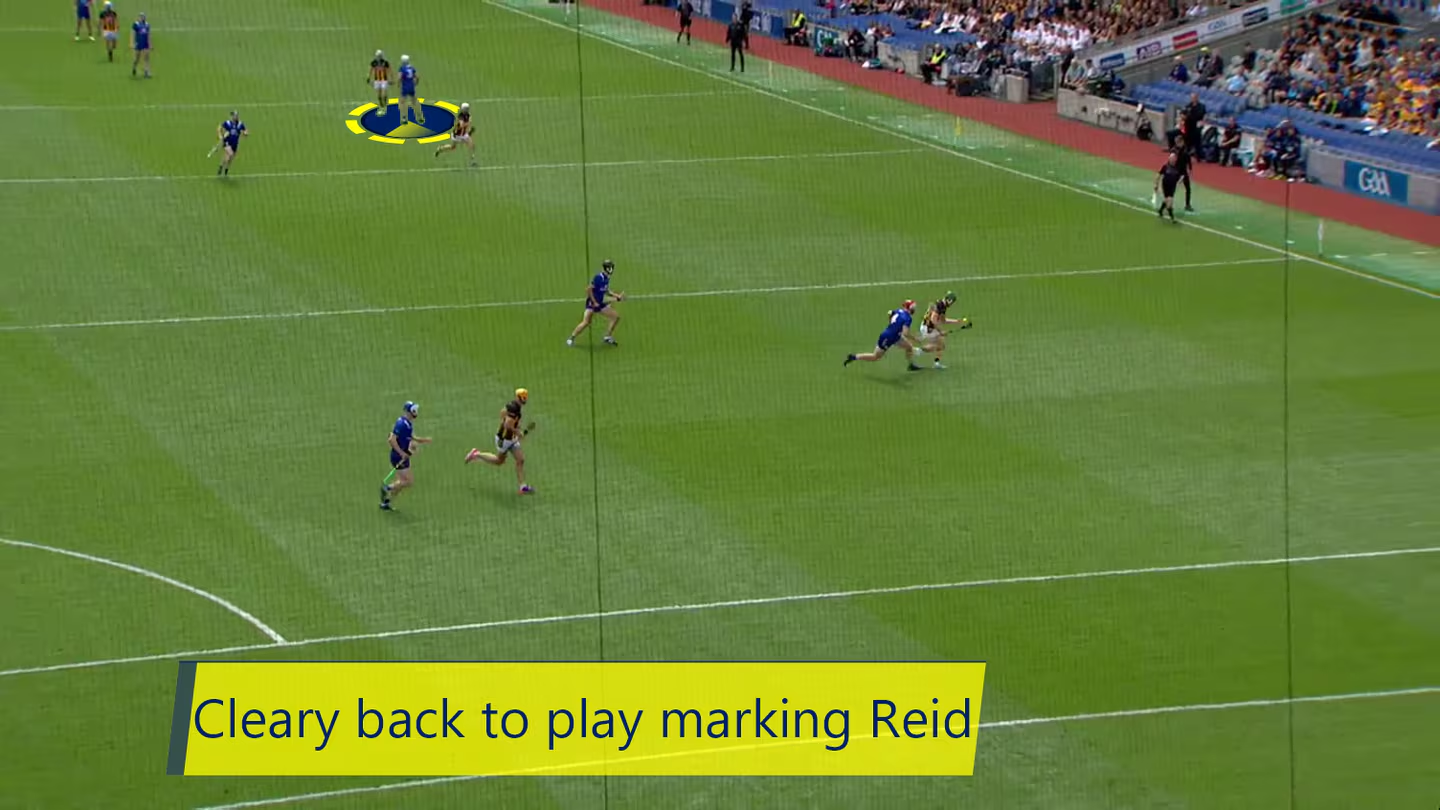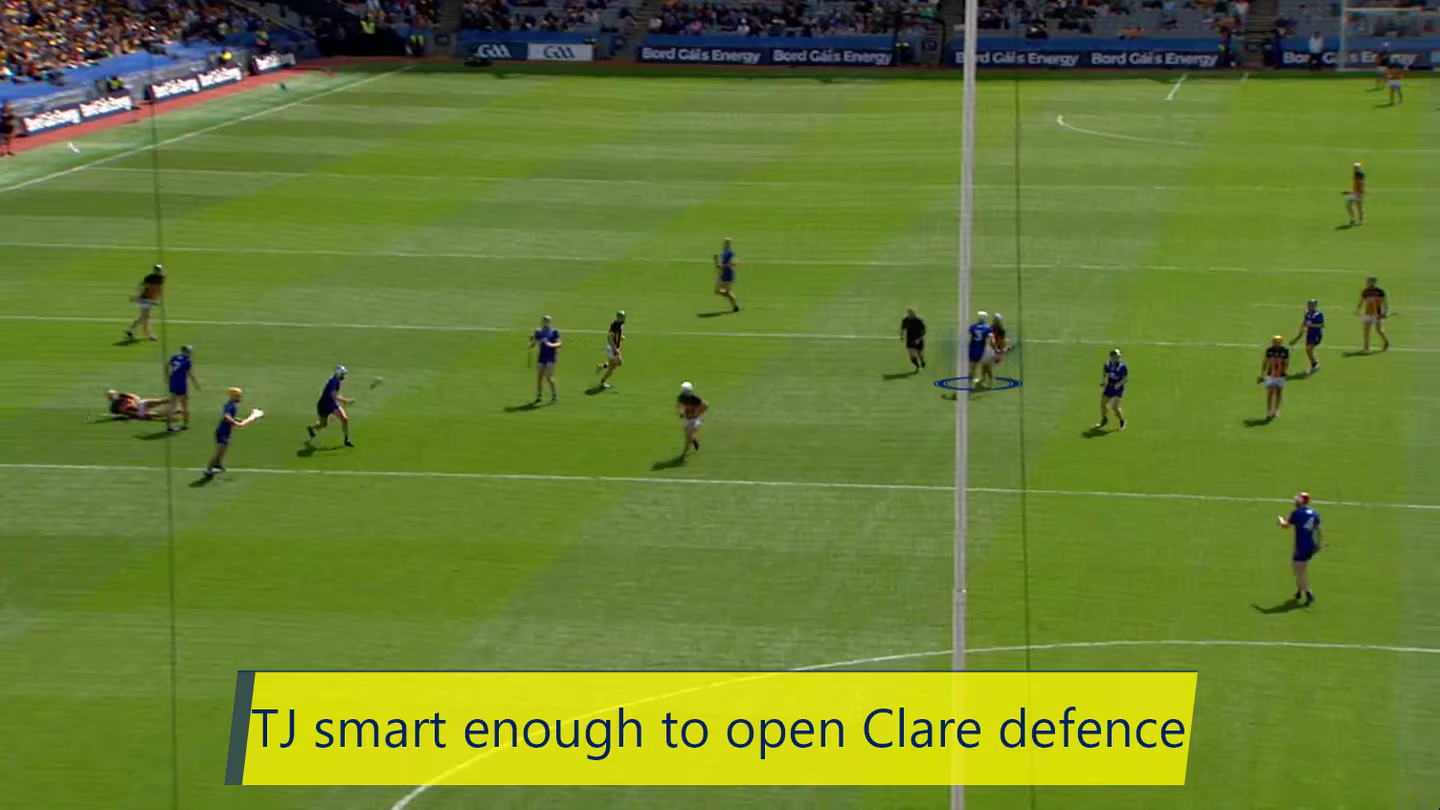Tactical breakdown: Cork’s space invaders manage to find chinks in Limerick armour
The great thing about both games at the weekend was they were completely different from each other. And within each game, the teams had to do different things for spells — doing what was required to get over the line.
Cork v Limerick
From the start, it was apparent Cork had identified a number of minor chinks in the Limerick armour that they wanted to go after. One of these was the full-back line. In advance of the game, I assumed that the loss of Barry Nash was going to really affect Limerick in possession — he is excellent at linking ball out of defence — but it was more his defensive absence which Cork went after.
Cork deployed Brian Hayes and Alan Connolly further from goal than they usually would. This tested the mobility of the Limerick full-back line. Brian Hayes ended up man of the match as he scored 1-4, while Alan Connolly scored 0-3 operating in that slightly withdrawn role. Connolly was also the provider for Patrick Horgan as he claimed his 700th point in championship hurling.
There were several huge physical battles and moments in the game. Ciaran Joyce brought a massive physical edge to the game and his tussles with Gearóid Hegarty were seismic. Cork went after Hegarty physically, a Tim O’Mahony block on him in the 40th minute was followed by Joyce winning the ensuing ruck and then a free, which Declan Dalton fired over from inside his own 45.
Diarmuid Byrnes and Séamus Harnedy had a similar battle with the Cork man coming out on top, scoring 0-4. Their contest was summed up in the first half with two Cork puck outs in a row, one which Byrnes pulled from the sky and fired back over Patrick Collins’s bar before it was rifled back at the pair and Harnedy won clean possession.
As mentioned above Connolly was abrasive all over the field. A 30th-minute turnover leading to a point, where he and Shane Barrett stripped Declan Hannon and an off-colour Will O’Donoghue, was a statement of their desire to work and attack Limerick’s big men.
Another big moment of intent was the Tim O’Mahony pull in the throw-in at the start of the second half, leaving his mark on O’Donoghue. The biggest one of the lot was the Ciarán Joyce hook on Aaron Gillane as he tried to pull on the rebound after Collins had saved Hegarty’s effort on goal. Cork scrambled the ball clear and the move ended with Dalton again scoring from distance. A big swing on the scoreboard.

The work rate of the Cork forwards was typified by Alan Connolly in the 30th minute, winning possession from Will O'Donoghue and heading straight for goal
Cork’s avoidance of Kyle Hayes’s channel was similar to the ploy used in the round-robin fixture in the Munster Championship. Collins decided to avoid the 7 area with his puck outs, where Hayes is so good under the dropping and from where he likes to start his marauding runs forward. The ball didn’t go there, so these runs, which bring so much energy to Limerick, were stopped.
This would have been expected by Limerick and it is interesting that they didn’t try to utilise Hayes in a different role to ask questions back of Cork.
Cork tried to isolate and then hit Brian Hayes with long puck outs from Patrick Collins
Cork were magnificent in the third quarter of the game, which saw a nine-point swing in favour of the Rebels. This was down to Cork dominating both puck outs. Cork actually won the first six puck outs of the second half and ruthlessly scored a point off each.
The first three puckouts were long straight ones down on top of Hayes in an aerial mismatch. Cork won the breaks for all three, with Shane Barrett making hay, much like he did in their early summer meeting. Then Collins added variety with a short one, which was worked to Barrett, while Collins also hit a moving Darragh Fitzgibbon and Declan Dalton out wide between the 65s.

Cork's puck-out strategy was vital to their strong start to the second half
The transformation in Cork’s puck out since the Waterford game is incredible. Their 55th-minute puck out highlighted Collins’s game intelligence. Kyle Hayes got his only score as he was found by a Gearoid Hegarty “golf” sideline and carried forward, but immediately Fitzgibbon raided into the area vacated by Hayes and Collins lasered the puck out over into the empty grass, and Fitzgibbon comfortably pointed.
Limerick's sideline ball ploy worked, but it was also used against them as Cork tried to exploit the space created
It is worth saying that Limerick are far from finished — this is not the end of an era by any stretch of the imagination. They lost by just two points. Cian Lynch was excellent in midfield linking play and Aaron Gillane was an outlet up top for Limerick all day, scoring 0-6 from play — both were magnificent throughout.
Limerick were seven down in the 51st minute when they decided to bring on some of the young guns and it was evident they all knew their role. Shane O’Brien and Adam English came in, both won a clean aerial puck out each and took six shots between them, scoring 0-2 each. The Limerick mantra of shooting at the posts is very much embedded in the next generation.
They fell one short of their 30-point target, which usually sees John Kiely and Paul Kinnerk’s team to victory. They know 30 points is the magic number it typically takes to win at senior intercounty level, even if they came up short this time round.
Kilkenny v Clare
Clare’s puck-out defence meant that Eoin Murphy was offered short options. In the first half, Kilkenny hit six short puck outs. This route almost paid huge dividends for Kilkenny after a Murphy short to David Blanchfield who did his trademark dummy and delivered long, but the move ended with a great Eibhear Quilligan double save from Cian Kenny and Adrian Mullen.
Kilkenny did get a return in the 24th minute, with Eoin Cody’s goal — that came about after a short puck out to Richie Reid was delivered long to Cody who raced across the field into the vacated area to win and round Adam Hogan.
So of the six short puck outs in the first half, the return to Kilkenny was one goal. Clare offered up the short puck out even more in the second half, with 14 of Kilkenny’s 23 going short. The return off these 14 puck outs was a solitary John Donnelly point.
Kilkenny tend to strike the ball long after the initial short puck out and bypass the middle third. Clare regained possession on 10 of these 14 short puck outs by the time the ball was in the Clare half of the field. Adam Hogan managed to win four of these as the Kilkenny backs tried to find the runs of Cody. The Kilkenny return for the full game from the 20 short puck outs was 1-1. A mere 2.0 productivity (productivity is a measure of scores per every 10 team possessions).
Kilkenny's attempted to create space for Eoin Cody to be found, but ultimately their puck-out strategy didn't yield scores

Kilkenny's short puck outs didn't yield many scores over the course of the game
Hogan was the winner of his duel with Cody — he is an outstanding man-marking corner back, relishing the challenge of going up against marquee opposition forwards. He also won four frees coming out in possession of the ball and a fifth when fouled by Cody as they tussled to get to the ball first.
It was obvious that this was something that gnawed at Kilkenny as TJ Reid expressed his frustration to the ref in the second minute as Hogan won his first free. The same happened in the NHL Final in April between the same two teams, where the Clare man won four front-foot frees coming out with possession.
Adam Hogan won a number of front-foot frees for Clare coming out with the ball against Kilkenny
Hogan wasn’t the only Clare defender who won their battle in the man-marking stakes. Clare had all three Ballyhale forwards well marshalled. Conor Cleary was given the task of detailing Reid, a smart match-up, where the Clare man stuck to his task and didn’t allow Reid to influence the game in his typical manner. Cleary is most comfortable on the edge of the square but he was resolute in his marking — even when Reid ventured out the field, he continued to mark like a full back.
David McInerney was tasked with looking after Adrian Mullen when he was in the Clare half of the field and he won that battle too. These were three big notches on the Clare belt, although this man-marking approach was tested in the first half, as Kilkenny were able to pull the Clare defence around and out of shape. If Mossy Keoghan and Mikey Carey had been more efficient Kilkenny could have held an insurmountable half-time lead. Clare very much went man-for-man and there was no cover. John Conlan was stepped on John Donnelly and didn’t step off as much as he typically does.

Conor Cleary is seen here with his back to the play marking TJ Reid, concentrating solely on his man even while a long way from the goal

TJ Reid was able to use the attentions of Conor Cleary to create holes within the Clare defence
Paul O’Brien is a performance analyst with The Performance Process (twitter.com/NoPlanBGAA).

